
This is the fifth excerpt Boulder Weekly has published from the Windows, Walls, and Invisible Lines: Portraits of Life in Sanctuary project. It’s been a few months since the last essays ran, so let me offer a brief reminder regarding the project.
The goal is to photograph and interview everyone in the United States who has taken public sanctuary in a church to avoid deportation which would result in family separation and likely harm to people being returned to their country of origin. I am also interviewing a few people in non-public sanctuary along the way — “non-public” referring to those who have sought protection inside of churches but have chosen to keep their identities and whereabouts private. There are two people in non-public sanctuary represented in this week’s excerpt.
When completed, the project will culminate in a book and a traveling photo exhibit that also has the ability to suddenly appear in unexpected places. The photos and interviews will also be used in collaborative projects with Motus Theater.
When I started this effort in March 2018, there were an estimated 25 to 30 people in 22 states who had taken public sanctuary in churches to avoid deportation and family separation. At that time, the best estimate for people who had taken non-public sanctuary in the United States was just over 100, but that figure was clearly just a best guess.
As of July 2019, there are now 44 people in public sanctuary and the number in non-public sanctuary is even less clear. As the Trump administration’s assault on immigrants intensifies by the day, the number is likely growing.
In recent days, it appears the invisible line that protects people who have taken sanctuary in churches may be about to get tested.
On July 1, the Trump administration began sending letters to people in public sanctuary informing them that they will be receiving massive fines for having not left the country when ordered to do so by Immigration and Customs Enforcement (ICE).
One of the people receiving such a letter last week was Edith Espinal, whose essay you will find on page 26. I spent time with Edith last December in Columbus Ohio. She is an outspoken, 43-year-old mother of three who has been living in sanctuary for the past 21 months. She used to live with her husband and children in a small apartment in Columbus, the city she has called home for more than 20 years. Their family never had much, but what they did have was a happy home where they ate meals together and as Edith put it, “enjoyed the little things.” Edith is being fined $497,777.
She understands that the purpose of this fine has nothing to do with the government trying to get money from her or her family. It is an impossible amount because its purpose is simply to be cruel — to send a message to other leaders in the sanctuary movement, like Edith, that they could be next.
At least one person in Colorado has received a notice of fine and it has been reported that others have as well.
Ingrid Encalada Latore, who has been in sanctuary in a Boulder church for the past 19 months, received notice that she will be fined nearly $5,000. She says she was shocked and thought the amount was excessive as she has no way to make money while in sanctuary. But then she started hearing of others whose amounts are closer to a half million dollars and realized it could have been worse.
As of this writing, it is being reported that 12 people in sanctuary have received a notice of fine so far and that number is expected to rise.
What is unclear is why the fines are being levied now and what might happen next.
In speaking with people in sanctuary this week as well as with those whose organizations support the sanctuary effort, it’s clear there is fear that the fines are somehow a precursor to coming efforts to remove people from the churches. But at least for now, such fear is based only on speculation.
It does seem the timing of the fines is suspect, with Trump having announced his intent to launch mass deportations of undocumented immigrants the same week that the letters went out to those in sanctuary.
As I wrote in the original introduction to this project, these “invisible lines” are important to all of us, not just our immigrant neighbors who have sought safety behind them.
We should all be aware that the long-held considerations that have protected immigrants in sanctuary thus far, as well as the sanctity of our religious institutions themselves, are under grave threat. Their violation is only a tweet away.
These invisible lines of protection may be powerful, but they are also vulnerable. They are no more than a manifestation of our past cultural sensitivities, protections willed into existence by our better angels in days gone by, presumably to protect us from ourselves should darkness one day descend upon our nation.
I believe that darkness has come. And we would do well to realize that it is not just our persecuted migrant friends who are in refuge within these lines and behind these walls, it is all of us who now hope and wait for our country’s sanity and compassion to again show itself.
If these invisible barriers built of history, empathy and respect for religious freedom should fall, all of us and the country we call home will be forever changed. In many ways, these lines that form our islands of sanctuary are our nation’s last line of defense against the hatred and totalitarianism that has swept over us. For all of our sakes, we must fortify them by any and every means possible.
That is the hope and intent behind this project.
______________________________________________________________________________
Ded Rranxburgaj
Detroit, Michigan
Time in sanctuary: 18 months

These are difficult times for 49-year-old Ded Rranxburgaj, an Albanian immigrant who has lived in the U.S. for the past 18 years. While taking a smoke break on the rooftop of the Central United Methodist Church in downtown Detroit, where he took sanctuary in January 2018, Ded tells me that his life is getting harder with each passing day. It’s winter and Ded says that’s the worst time. The rooftop garden he tends in the summer, which provides fresh vegetables to Detroit’s homeless population, is now dead. The pots — still sporting the brown, dead stalks of what once was — seem a perfect fit on this gray Detroit day.
Ded says in winter, he and Flora, his wife of nearly 30 years, are mostly trapped in their room staring at each other for hours on end with increasingly less to say. “If you don’t go out, if you don’t work or do anything, what do you have to talk about?”

Photo by Joel Dyer
He admits that on some days, “Albania doesn’t seem so bad. At least I could walk around. Then I remember how it was. I can’t leave my wife. She was down to 72 pounds and in a wheelchair. I help her do everything. And they tell me to just leave, leave her here to die with strangers. I won’t do that.”

Photo by Joel Dyer
Ded came to the U.S. in 2001 on a legal visa, which he overstayed. The man from Albania is a fixture at the Coney Island restaurant where he says he has worked for years without taking any time off. “I’ve made a million hotdogs for people,” he says through what almost resembles a smile. Like most of those being targeted by the Trump administration, Ded has never had any trouble with the law. He is just a man who considers this country his home after nearly two decades, a man who works hard, pays taxes, feeds the homeless and who refuses to abandon his sick wife for whom he is the sole caregiver.
How is Ded a threat to this country? That is a question no one can answer.
*****
Francisca Lino
Chicago, Illinois
Time in Sanctuary: 23 months

Photo by Joel Dyer
To say that the Adalberto United Methodist Church in Chicago’s Humboldt Park district is small would be an understatement. The church’s storefront window could barely hold the eclectic manger scene that had taken over the space when I stopped in to see Francisca Lino, a 51-year-old mother of six. Originally from Mexico, but having lived and worked in the U.S. for the past 18 years, Francisca has now been in sanctuary at the church for nearly two years.
Adalberto was quite a contrast to many of the sanctuary operations I have visited in the past year. In some places, a single large church with dozens of volunteers support the person in sanctuary. In other places several churches with hundreds of volunteers have come together to meet the needs of an individual or family in sanctuary. Adalberto is a tiny church that couldn’t hold more than 30 people on a busy Sunday. Its activist pastor has to work a day job just to pay the church’s rent and keep the doors open. Yet despite such challenges, Francisca is the third person protected by sanctuary in this church that clearly has more faith and willpower than resources. No army of volunteers here. Francisca shares Pastor Jacobita Cortez’ small apartment upstairs from the sanctuary along with the pastor’s daughter and two grandchildren.
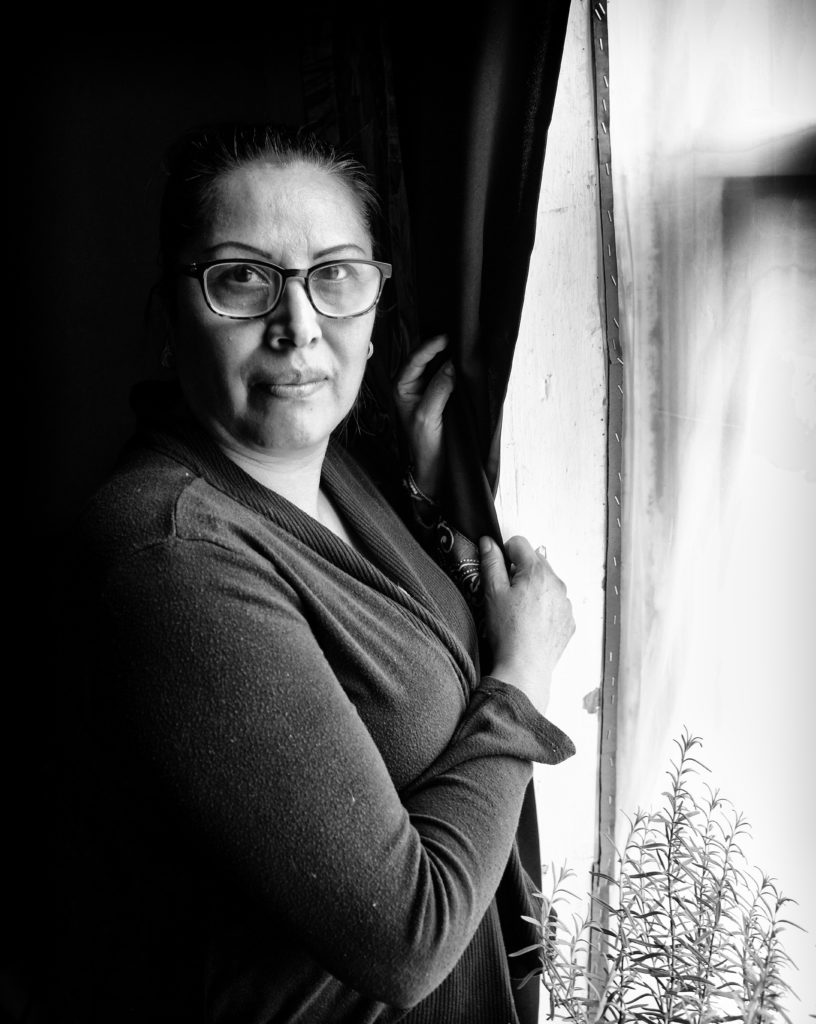
Photo by Joel Dyer
On the day she was to be deported, Francisca had already purchased her plane ticket and packed her clothes, but on the way to the airport she decided to take sanctuary in the church she had been attending faithfully for 15 years.
“I just could not leave my family,” she says.

Photo by Joel Dyer
Since entering sanctuary nearly two years ago, life for her family has been hard. Her husband works long nightshifts and now struggles to support the family financially without the money Francisca once made. Her oldest daughter, now 18, is struggling with depression. Even though the family regularly visits on weekends, Francisca admits that she doesn’t feel like she is really there for her husband and children. “No one can prepare for this. No one can prepare to be separated from the people you love and who need you,” she says.
Later in the afternoon, Francisca shows me a picture of her family that hangs on the wall in the sanctuary. Her husband and five of her children are present. There is a birthday cake in the center with two candles, a one and a six. Her 16-year-old twin daughters are seated at the cake ready to blow out the candles. As Francisco explains the photo to me, her eyes fill with tears. She explains that the photo was taken last year at the church after she had taken sanctuary. She said it was hard to celebrate such an important day in that way. She then confides that “tomorrow is their 17th birthday,” and that the family will once again be celebrating the event at the church where Francisca has, for all intents and purposes, imprisoned herself in order to keep her family together in at least some fashion. “I never thought I would still be here a year later,” she says. “I hope this is the last time we have to do it here.”
*****
Vicky Chavez (with her two young daughters)
Salt Lake City, Utah
Time in Sanctuary: 18 months

Photo by Joel Dyer
You can’t cut it any closer than Vicky Chavez did in January 2018. After being ordered to leave the country by ICE officials, Chavez bought plane tickets for herself and her then 4-month-old and six-year-old daughters. She packed their few belongings, went to the airport and even checked in for the family’s deportation flight. But then she became overwhelmed by what would be waiting for her and her small children when the plane landed.
In 2014, Vicky and her then-3-year-old daughter fled their home town of San Pedro Sula, Honduras, a city widely regarded as one of the most dangerous and violent in the world. Vicky left her home country because she says she was experiencing sexual violence and domestic abuse. She said things were rapidly deteriorating and that both she and her daughter were told they were going to be killed. Vicky chose to flee to the U.S. because she hoped to apply for asylum — which she says she did immediately upon her arrival — and because her parents already lived here legally.

Photo by Joel Dyer
Despite doing all the things her attorney instructed, Vicky and her daughter’s asylum request was eventually turned down by the courts. She says she still doesn’t understand why but suspects that her legal advice may have been flawed. After her appeals also failed, Vicky, who had another daughter in 2017 (a U.S. citizen) was ordered to leave the country and return to Honduras even though she has no immediate family, no job prospects and no way to feed her children there. And as Vicky put it so bluntly, “I knew I might be killed if I went back and that meant my children could be killed as well.”
So, standing in the Salt Lake City airport waiting to board her plane to what she believed would be the death of her family, Vicky suddenly changed her mind. She asked one of the activists who had come to see her off if she would take her to a church where she and the girls could take sanctuary.
That was 18 months ago and Vicky, now 31, along with her nearly 8-year-old daughter and her nearly 2-year-old daughter, who has no real memories of life outside of sanctuary, are still spending every day of their lives inside the walls of Salt Lake City’s First Unitarian Church. They live in a converted classroom.

Photo by Joel Dyer
Vicky does her best to make the girl’s lives as normal as possible under conditions that are anything but. She tries to always keep a good attitude and a smile on her face when around the kids. She told me the only time she lets herself be sad is when they are both asleep.
Vicky has no idea how long she’ll be both imprisoned and protected within the church walls she now calls home. And while she hopes to have her case for asylum reopened at some point, she says no matter what happens, she knows she made the best decision for her children. “At least we are all together and safe, and that is more important than anything else.”
*****
Saheeda Nadeem
Kalamazoo, Michigan
Time in sanctuary: 16 Months
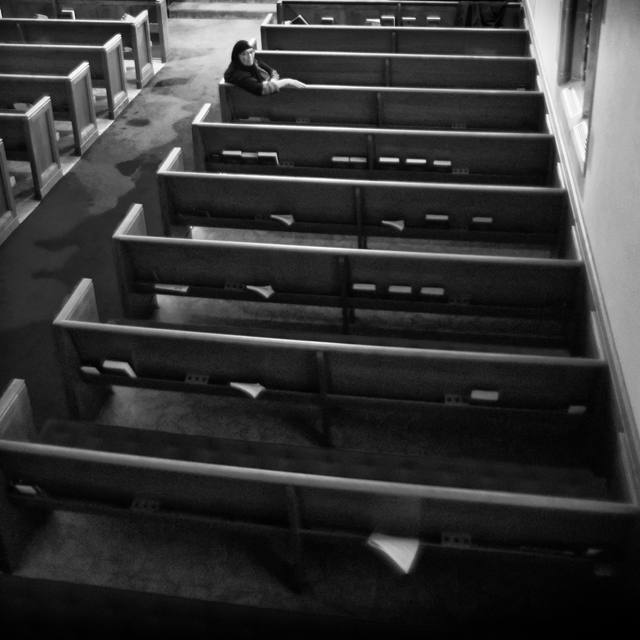
Photo by Joel Dyer
Saheeda Nadeem came to the United States 14 years ago on a non-immigrant visa. Her goal was to create a better life for her two elementary-aged children, her daughter, Lareb, and her son, Samad.
Saheeda was born in rural Pakistan 63 years ago. Her parents helped her to gain her education and then, while she was still a teenager and sensing that her opportunities would be greatly limited if they stayed in Pakistan, her family immigrated to Kuwait, where Saheeda became a domestic servant. After years in Kuwait, Saheeda still wanted more opportunity for her children than what she had been given. That’s why she decided to come to the U.S. around 2005.
Saheeda and her kids found a home in Kalamazoo, Michigan, where the woman from Pakistan would become a beloved part of the community. She is known as “Auntie Saheeda” for her decade of work with disabled adults in a group home setting and as a parental figure for orphaned refugee children relocated to the Kalamazoo area.
After her visa ran out, Saheeda was granted annual deferments from deportation. But after Trump took office, ICE ordered her deported back to Pakistan, a country she has not set foot in for more than 40 years and where she has no known family or friends.

Photo by Joel Dyer
The area where Saheeda is from in Pakistan is very strict in its Muslim teachings. While Saheeda is herself a devout Muslim, she fears that without having a male family member, her life will be in danger. For these and other reasons, Saheeda’s family and friends believe she may be killed if deported to Pakistan.
For her part, Saheeda says she simply can’t leave her children. Sadly, her daughter, Lareb, was killed in a car wreck in 2016 just as she was graduating from college. Saheeda took comfort in visiting her beloved daughter’s grave every single day before being forced to take sanctuary in Kalamazoo’s First Congregational Church. She told me not being able to visit her daughter’s grave is the hardest part about being in sanctuary. When asked if she struggles with boredom after working so many hours prior to being in sanctuary, she smiles and says, “No, I eat three times a day and I pray five times a day. I am still very busy.”
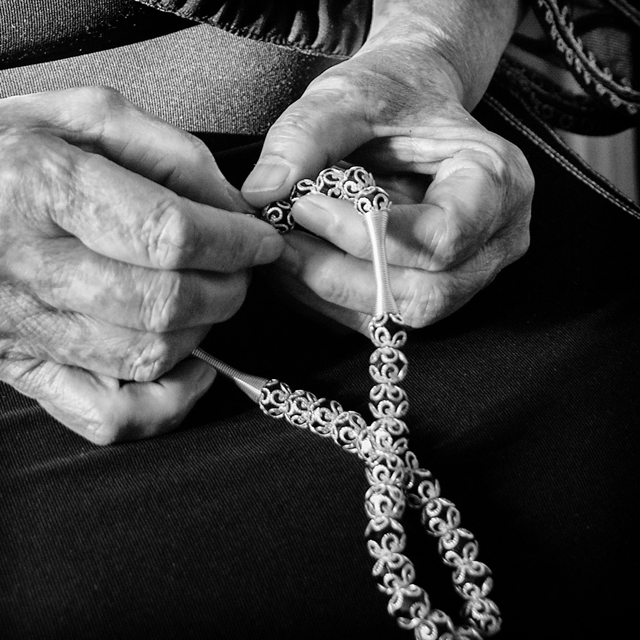
Saheeda’s son Samad is still in college and protected for now by his DACA status. He is a passionate and outspoken advocate for his mother and increasingly for all those threatened because of their undocumented status.
He says if his mother is deported he will go to Pakistan with her because her life could well depend on it. But as a young man who has grown up in the United States, it is certainly not the preferred outcome for himself or his mother.
As for this historic old church in Kalamazoo that has so kindly provided sanctuary for Saheeda, it is just the latest in a long history of such social justice actions. The church was actually the last stop on the Underground Railroad so many years ago. Oh, how little has changed.
*****
Jorge Taborda
Las Cruces, New Mexico
Time in Sanctuary: 26 months
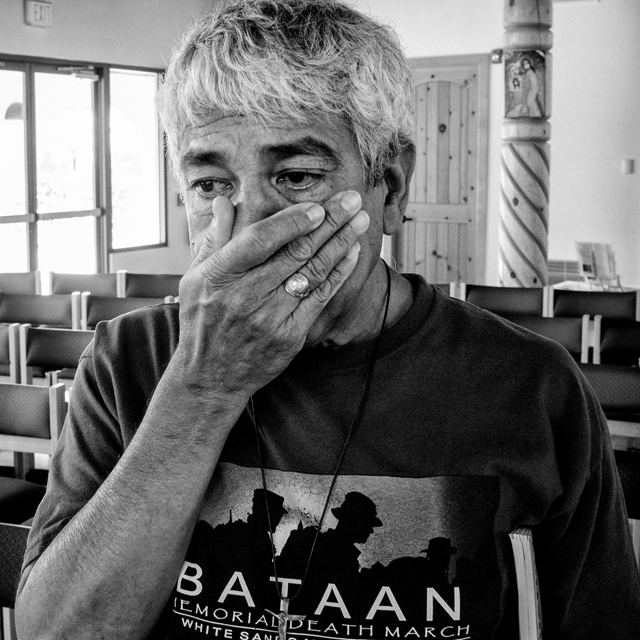
Photo by Joel Dyer
Jorge Taborda covers his mouth with his hand and his eyes fill with tears as he recounts the day that saw his family torn apart. It’s as if he is trying to stop the words from escaping, as if not telling the story can undo what has been done. But after a bit, the words come.
It was in May 2017, Jorge was at the hospital with his 14-year-old son, Stephen. It was a planned appointment. Stephen has been receiving treatment for a neck ailment his entire life. Then Jorge’s cell phone rang. It was his wife. ICE agents had stopped her on her way to work and she was being taken to nearby El Paso, Texas, to be processed for deportation. Agents had also picked up the couple’s oldest son, Jeff. She told Jorge not to go home. As Jorge and Stephen rushed from the hospital – not sure what was happening with the rest of their family – undercover ICE agents wearing street clothes were waiting in the hospital parking lot. They stopped Jorge and Stephen, who is a U.S. citizen having been born in this country after his parents came here fleeing persecution in Colombia 22 years ago.
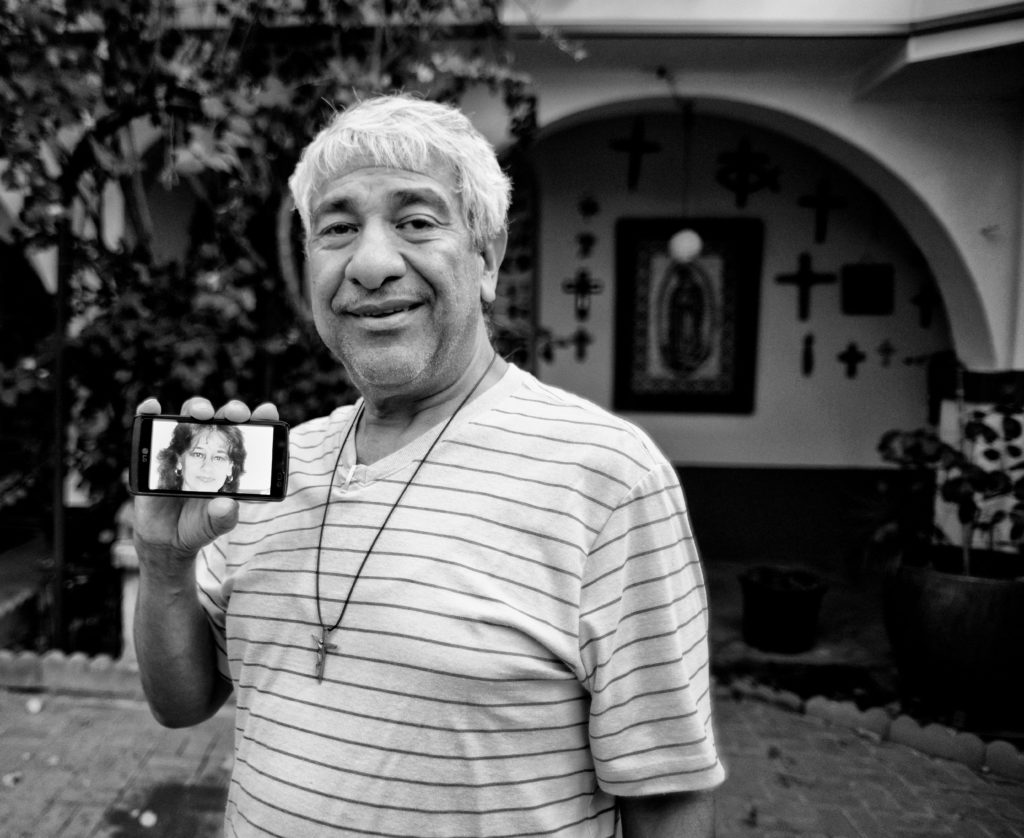
Photo by Joel Dyer
Jorge pleaded with the agents to allow him to drop off his son at school before following the agents to the border patrol facility in El Paso. They acquiesced. On the way to the school the two went over the plan they had practiced so many times. Stephen would stay with another family who had been granted power of attorney for just such a situation. They prayed together and Stephen went into the school. Jorge started driving through Las Cruces with the agents behind him. He was supposed to take the highway to El Paso. At some point he realized he would be driving somewhat near the small Catholic church his family had been attending. And although he says he hadn’t previously planned it, when he came to the road that led to the church he suddenly turned. The agents were not pleased. At one point, according to Jorge, they rammed the rear of his car in an effort to force him to pull over. He showed me the dents in his car as his proof. At that point, Jorge says God took over and drove him into the church parking lot of Our Lady of Health, Roman Catholic Church. The agents parked across the street and as has been their instructions for many years now, did not enter onto church property in their pursuit.
Later that night, Jorge was slipped out of the Catholic church and moved to the nearby Holy Cross Retreat Center, a 36-acre spiritual facility nestled among abundant pecan orchards and run by the Franciscan Friars.

Photo by Joel Dyer
Jorge and Stephen have now been living in sanctuary at the center for over two years. Jorge’s wife was deported back to Colombia, where she is struggling to get by. The couple speak by phone most days. Jorge often sets his alarm for precise times in the middle of the night so he can call his wife to pray with her at optimal times according to their beliefs.
I don’t claim to understand much about Catholic rituals, but it is clear that Jorge’s faith is the glue that is holding his family together across two continents. Jorge is self-imprisoned in a place with many freedoms, his wife is free in a place that feels like a prison.

Photo by Joel Dyer
Jorge recognizes that his sanctuary location offers many advantages over those of his peers. He can go for long walks outdoors, which he often does, strolling through the rows of pecan trees. He also helps out around the center doing small maintenance jobs, mostly so he feels he’s still contributing… to something. Jorge says he prays everyday that his wife will somehow be able to rejoin him in New Mexico once he is able to leave sanctuary. It may indeed take a miracle to make that happen, but I wouldn’t bet against this family.
*****
Edith Espinal
Columbus, Ohio
Time in sanctuary: 21 months

Photo by Joel Dyer
For most people, getting a letter from the federal government saying you owe a fine of $497,777 for failing to leave the country would be considered a really bad day, but for Edith Espinal, it is just another hard day in sanctuary.
Edith was ordered to leave the U.S. in 2017, but she simply could not bear the idea of leaving her husband, Manual, and their three kids, Stephanie, Isidro and Brandow. Originally from Mexico, Edith has called Columbus, Ohio, home for more than 20 years, and as much as she has grown weary of living in her self-imposed confinement in the Columbus Mennonite Church, she will gladly endure more time in sanctuary if it means keeping her family together.
Edith is no wallflower. The 43-year-old woman is an outspoken leader in her community. She has been very critical of the Trump administration and its handling of the immigration issue. Many believe that it is her activism that has put her on the receiving end of the government’s massive fine, a fine so ridiculous in its size that it would be impossible for Edith and her family to ever pay. But Edith doesn’t think that getting money was ever the point behind the fine. She has made it clear to all who will listen that she believes the fines — which are also being sent to other people living in sanctuary — are simply designed to inflict pain, cruelty for cruelty’s sake.

Photo by Joel Dyer
But Trump’s fine won’t stop Edith. Last time I spoke with her she told me what a truly bad day in sanctuary looks like. She described the helplessness she felt when she was told that her son Brandow had been injured in a car wreck. She had no idea how serious his injuries were. She was only told that he had been taken to the hospital with a head injury.
She wept knowing that she could not leave sanctuary to go to her son in his time of need. When Brandow was eventually released from the hospital, he moved into the church with his mom so she could take care of him as he recovered.
“That,” says Edith, speaking of the accident, “is a bad day.”
She insists the fine will not silence her, and I, for one, believe her. Edith Espinal is enduring sanctuary because she is an amazing mother who cares more for her family than herself. And she will continue to be a leader because she cares more for her community than herself as well.
*****
Diego (not his real name)
Eastern U.S.
Time in non-public Sanctuay: withheld
upon request

Photo by Joel Dyer
There are many reasons why some immigrants ordered to leave the U.S. have taken sanctuary, but not publicly. In many cases it is because they will, with almost absolute certainty, be killed if returned to their countries of origin.
That is most definitely the case with Diego, whose real identity, country of origin and current location in sanctuary I have agreed not to reveal.
As a teenager, Diego and a close friend were walking together in their hometown when members of the MS-13 gang shot and killed Diego’s friend. Eventually, the police persuaded Diego to identify the murderers. After that, the gang beat Diego badly, injuring him and putting him in the hospital. Diego knew that when he was released the gang would likely finish the job.
It was then, lying in a hospital bed half dead, that the young man decided he would leave his country immediately and head north to the U.S.
Diego made it. He started a new life for himself, got married and had a son. His marriage has since ended, but Diego is single-handedly raising his 4-year-old son who now lives with him in sanctuary.
If returned to his country of origin, Diego says he would not be alive for long and he doesn’t know what would happen to his son. “I can’t take him with me into that. And I can’t just leave him behind not knowing what will happen to him,” he says.
Diego has explained all this to ICE, but he was still ordered to leave.
As in so many of these cases, deportation is little more than a death sentence.
*****
Alejandra (not her real name)
Midwest
Time in non-public Sanctuary: 14 months at the time I saw her last

Photo by Joel Dyer
Alejandra is shy and quiet, at least around me. She has been in sanctuary for some time now both because of her status and because she is afraid of people she believes will hurt her.
Alejandra has had a hard life so far. She remembers always being abused. It started in her own family in her home country and followed her through relationships here in the U.S. Though we spoke for some time, there is little more that I can say here as she is a very private person.
She says she is now getting help and that talking about her past abuse is becoming easier.
She told me I could photograph her so long as she couldn’t be recognized. I took a number of shots. She liked this one best and, fortunately, so did I.
I think it captures all the things I wish I could write about her but have agreed not to. For now, a single photo will have to tell her story and the story of so many like her.
______________________________________________________________________________
For more information on this project and to see the previous four excerpts follow the links below:














